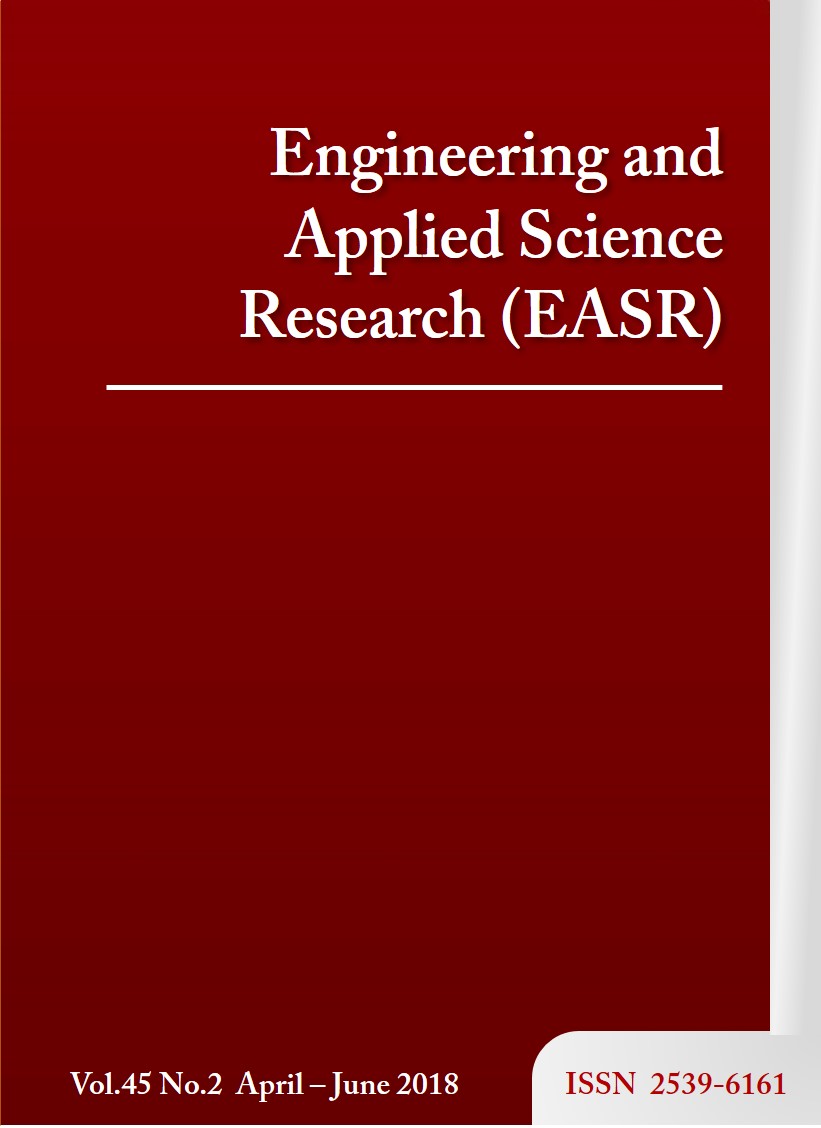Effects of extruding factors on mechanical and physical properties of polypropylene/rubberwood flour composites
Main Article Content
Abstract
The objective of this research was to investigate effects and interactions of extruding factors on the mechanical and physical properties of composites produced from recycled polypropylene and rubberwood flour. Central composite design (CCD) and response surface methodology (RSM) were applied to study the effects of temperatures in zones 1 and 2, as well as screw rotation speed of a twin-screw extruder. The results revealed that an increase of temperature in zone 1 resulted in increased tensile strength (TS) and hardness, but the modulus of rupture (MOR) and water absorption (WA) of the composites were reduced. Increased temperature in zone 2 decreased the TS and MOR of the composites, but the hardness and WA clearly increased. Furthermore, the TS, MOR and WA of the composites decreased with an increase of screw rotation speed, but hardness increased.
Article Details
This work is licensed under a Creative Commons Attribution-NonCommercial-NoDerivatives 4.0 International License.
References
Bajwa SG, Bajwa DS, Holt G, Coffelt T, Nakayama F. Properties of thermoplastic composites with cotton and guayule biomass residues as fiber fillers. Indus Crops Prod 2011;33:747–755.
Reis PNB, Ferreira JAM, Silva PAA. Mechanical behaviour of composites filled by agro-waste materials. Fibe Polym 2011;12:240–246.
Ratanawilai T, Nakawirot K, Deachsrijan A, Homkhiew C. Influence of wood species and particle size on mechanical and thermal properties of wood polypropylene composites. Fibe Polym 2014;15:2160–2168.
Gardner DJ, Han Y, Wang L. Wood–plastic composite technology. Curre Fores Repor 2015;1:139–150.
Salleh FM, Hassan A, Yahya R, Azzahari AD. Effects of extrusion temperature on the rheological, dynamic mechanical and tensile properties of kenaf fiber/HDPE composites. Compos B Eng 2014;58:259–266.
Phonngam P, Techawinyutham W, Chaikittiratana A. A study of parameters affecting extrusion process of wood plastic composites. NU Sci J 2013;10:26–32.
Lewandowski K, Zajchowski S, Mirowski J. Studies of processing properties of PVC/wood composites. CHEMIK 2011;65:329–336.
Thongpradid T, Vatanatham T, Limtrakul S. A study on melt rheology and extrudate swell of high density polyethylene in a single screw extruder. J Res Eng Technol 2008;5:355–364.
Homkhiew C, Ratanawilai T, Thongruang W. Optimizing the formulation of polypropylene and rubberwood flour composites for moisture resistance by mixture design. J Rein Plas Compos 2014;33:810–823.
Aminia M, Younesia H, Bahramifara N, Lorestanib AAZ, Ghorbania F, Daneshia A, Sharifzadeh M. Application of response surface methodology for optimization of lead biosorption in an aqueous solution by Aspergillus niger. J Hazar Mater 2008;154:694–702.
Aurrekoetxea J, Sarrionandia MA, Urrutibeascoa I, Maspoch ML. Effects of recycling on the microstructure and the mechanical properties of isotactic polypropylene. J Mater Sci 2001;36:2607–2613.
Montgomery DC. Design and analysis of experiments. 7th ed., John Wiley & Sons, 2009.
Ku H, Wang H, Pattarachaiyakoop N, Trada M. A review on the tensile properties of natural fiber reinforced polymer composites. Compos B Eng 2011;42:856–73.
Sathishkumar TP, Navaneethakrishnan P, Shankar S, Rajasekar R. Mechanical properties and water absorption of snake grass longitudinal fiber reinforced isophthalic polyester composites. J Rein Plas Compos 2013;32:1211–1223.



